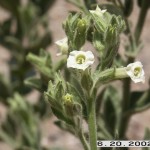Desert Tobacco
Nicotiana trigonophylla
Solanaceae (Nightshade family)
Description
Desert tobacco is a slender, erect plant that grows to about 1 to 3 feet tall. Its stems are covered with sticky hairs. The oval to lance-shaped leaves are 2 to 5 inches long and covered with soft, short hairs. They grow opposite each other on the stem, attached directly at the base. The five-lobed, greenish-white or yellowish, trumpet-shaped flowers are about 0.5 to 1.5 inches long. This day-blooming plant flowers year-round.
Habitat
The plant is often found in gravelly-sandy draws and arroyos.
Toxic Agent
All parts of desert tobacco contain the alkaloids nicotine and anabasine as toxic principles. In Texas, poisoning by this plant is rare, but cattle and horses are the species usually involved. Swine, sheep and probably goats are also susceptible. The toxic dose for horses is 0.5 percent of body weight in leaves; for cattle, it is reported as 2 percent of body weight. Lower plant consumption can produce birth defects when the plant is eaten during the first trimester of pregnancy.
Signs of Livestock Ingestion
These alkaloids affect the nervous and muscular systems, and the clinical signs may include: Incoordination; Muscle trembling; Salivation;; Frequent urination; Colic; Vomiting; Diarrhea; Death from respiratory paralysis; Birth defects: crooked legs and/or cleft palate.
Management Strategies
The plant is generally unpalatable to livestock and consumption must be forced. There may be some benefit to treating acutely poisoned animals with activated charcoal. Maintaining good range condition and an adequate forage supply is the best way to avoid problems.
Images
Plant Characteristics
Flower Color: White
Seed Type: Non-Encapsulated
Duration: Annual
Stem Texture: Hairy
Leaf Shape
 : Simple with Pinnate or Parallel Venation
: Simple with Pinnate or Parallel Venation
Season: Warm
Distribution
 : 02 - Gulf Prairies and Marshes, 06 - South Texas Plains, 07 - Edwards Plateau, 08 - Rolling Plains, 09 - High Plains, 10 - Trans-Pecos
: 02 - Gulf Prairies and Marshes, 06 - South Texas Plains, 07 - Edwards Plateau, 08 - Rolling Plains, 09 - High Plains, 10 - Trans-Pecos
Distributions
Distribution refers to the ecological region in Texas that a plant has been found. You can also view a clickable map.
Book: Toxic Plants of Texas (B-6105)
Collection: Toxics
Livestock Affected: Cattle, Goats, Horses, Sheep
Livestock Signs: Abnormal Urination, Birth Defects, Diarrhea, Excess Salivation, Incoordination, Irregular Breathing, Trembling, Vomiting/Regurgitation





